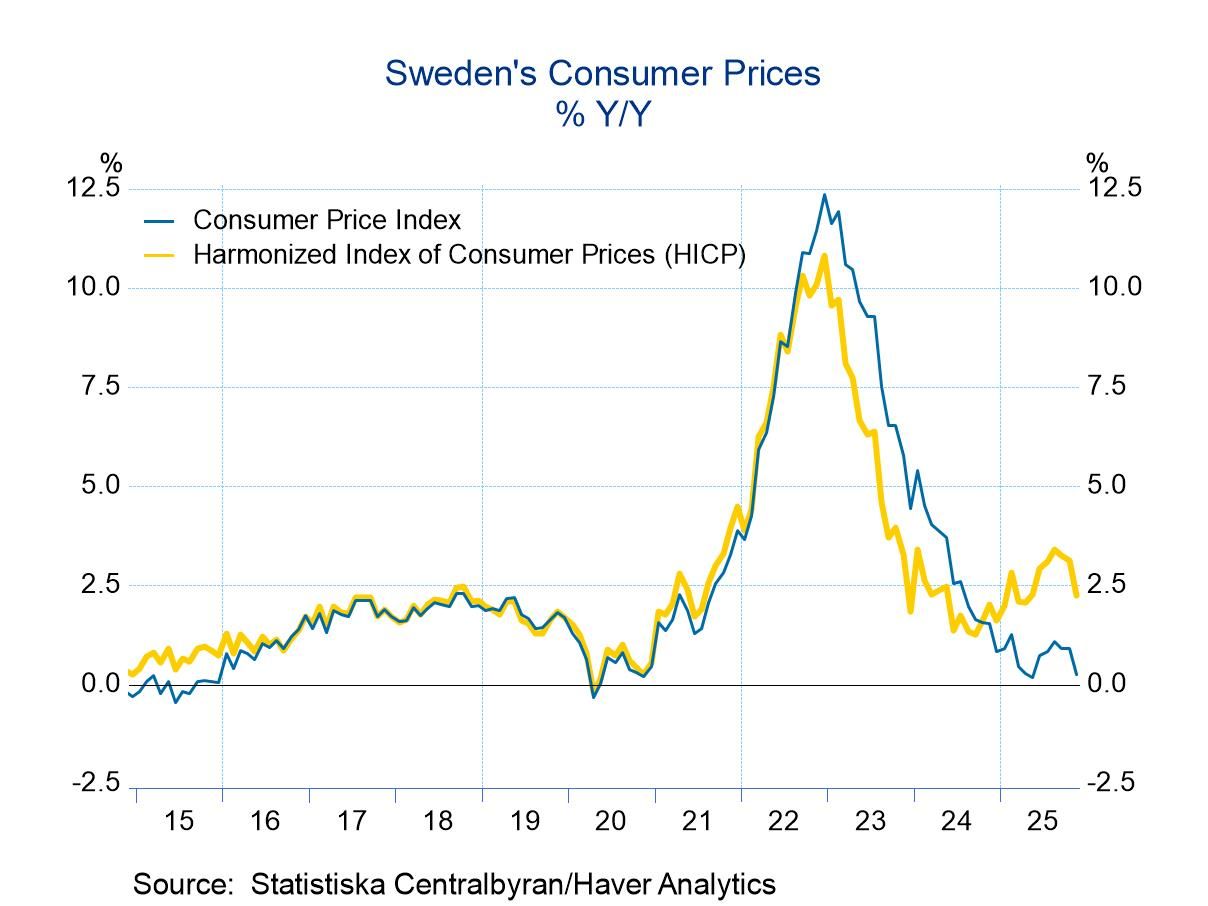 Global| Jan 14 2005
Global| Jan 14 2005Producer Prices Fell in December, Core Tame
by:Tom Moeller
|in:Economy in Brief
Summary
The PPI for finished goods fell 0.7% in December, reversed all of the prior month's gain and dropped more than Consensus expectations for a 0.1% dip. The indication of tame pricing power extended to a 0.1% rise in prices less food & [...]
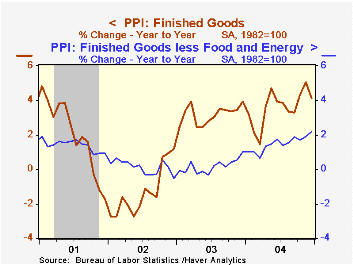
The PPI for finished goods fell 0.7% in December, reversed all of the prior month's gain and dropped more than Consensus expectations for a 0.1% dip. The indication of tame pricing power extended to a 0.1% rise in prices less food & energy which was half the Consensus expectation and the weakest figure since July.
Finished energy prices fell whopping 4.0% (+13.5% y/y) as gasoline prices fell 14.4% (+27.4% y/y), fuel oil prices fell 10.0% (+41.0% y/y) and residential natural gas prices slipped 0.2% (+15.7% y/y).
Though the trend in prices less food & energy firmed last year, the gain in December was under control as a 0.1% (2.0% y/y) rise in core finished consumer goods was the weakest since August. Unchanged or lower prices for apparel, passenger cars (+1.7% y/y), toys (+1.0% y/y) and furniture (+3.4% y/y) offset gains in prices for books (+4.6% y/y) and home electronics (-5.5% y/y). Finished capital goods prices also rose a modest 0.1% (2.4% y/y), the weakest gain since July.
Finished food prices also were well behaved. The 0.1% (2.9% y/y) gain was the weakest since September.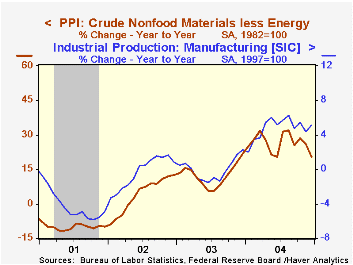
Intermediate goods prices fell for the first time in over a year. The 0.3% decline reflected a 3.8% (+14.7% y/y) drop in energy prices but a 0.8% (-1.9% y/y) gain in food prices. Core intermediate prices rose a firm 0.5% reflecting strength across categories, although recent weakness in housing construction has eased the earlier pressure on wood prices.
Crude prices slumped 2.9% as lower oil prices pulled crude energy prices down 7.3% (+37.3% y/y). The 1.7% decline in core crude prices reflected lower prices for iron & steel scrap (+48.6% y/y) but prices for copper scrap rose (35.5% y/y) as did aluminum scrap prices (+12.3 y/y). During the last thirty years "core" crude prices have been a fair indicator of industrial sector activity with a 48% correlation between the six month change in core crude prices and the change in factory sector industrial production.
| Producer Price Index | Dec | Nov | Y/Y | 2004 | 2003 | 2002 |
|---|---|---|---|---|---|---|
| Finished Goods | -0.7% | 0.5% | 4.1% | 3.6% | 3.2% | -1.3% |
| Core | 0.1% | 0.2% | 2.2% | 1.5% | 0.2% | 0.1% |
| Intermediate Goods | -0.3% | 0.8% | 9.0% | 6.6% | 4.7% | -1.5% |
| Core | 0.5% | 0.4% | 8.3% | 5.7% | 2.0% | -0.5% |
| Crude Goods | -2.9% | 8.7% | 18.2% | 17.6 | 25.1% | -10.6% |
| Core | -1.7% | 2.5% | 20.4% | 26.5% | 12.4% | 3.8% |
by Tom Moeller January 14, 2005
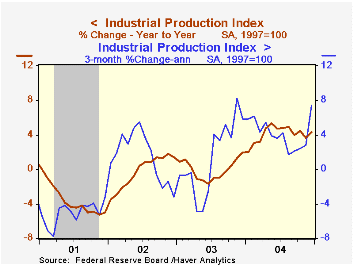
Industrial production finished 2004 on a strong note and surged 0.8%. The gain followed a downwardly revised 0.2% November increase but it doubled Consensus expectations had been for a 0.4% increase. The 4.1% gain in production for all of last year was the strongest since a 4.3% rise in 2000.
A 2.7% rise in electric & gas utilities last month boosted the production gain, but the factory sector nevertheless performed well. The 0.6% (5.1% y/y) rise in December factory sector output raised production 4.8% for the full year, the strongest since 1999.
The high tech sector contributed to the 2004 output gain with a 19.1% rise for the full year. Output of semiconductors & related equipment rose by nearly one third for the year though that rate of gain is half the growth logged during the late 1990s. Outside the technology sector, the 3.9% full year gain in factory output excluding high tech was the largest since 1997.
Output of appliances, furniture & carpeting added 0.6% (2.8% y/y) to a downwardly revised 0.9% November gain and for the year grew 4.8%. Clothing output turned in the best showing since April with a 0.8% (-4.2% y/y) rise but output still fell 6.2% for the year, the tenth down year in a row.
Total capacity utilization rose to 79.2% from an upwardly revised November. Capacity grew 1.2% y/y.
| Production & Capacity | Dec | Nov | Y/Y | 2004 | 2003 | 2002 |
|---|---|---|---|---|---|---|
| Industrial Production | 0.8% | 0.2% | 4.3% | 4.1% | -0.0% | -0.3% |
| Capacity Utilization | 79.2% | 78.6% | 76.8% (12/03) | 78.1% | 75.5% | 75.3% |
by Tom Moeller January 14, 2005
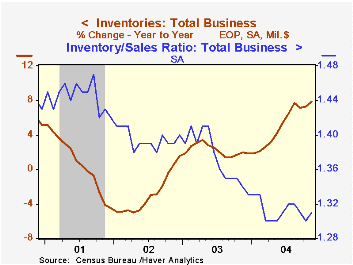
Total business inventories jumped 1.0% in November. The increase lifted the y/y gain to 7.9%, the strongest since 1995, in marked contrast to the decumulation of just a few years ago.
Wholesale inventories again jumped by 1.1%. During the last ten years there has been a 64% correlation between the y/y change in wholesale inventories and the change in imports of merchandise.
Retail inventories surged 1.1% due to across the board accumulation. Motor vehicle inventories rose 1.6% (7.8% y/y) and non-auto retail inventories nearly doubled the October increase with a 0.9% rise. Strong m/m gains were logged for furniture (+3.9% y/y), a general merchandise (5.5% y/y) and building materials (15.7% y/y).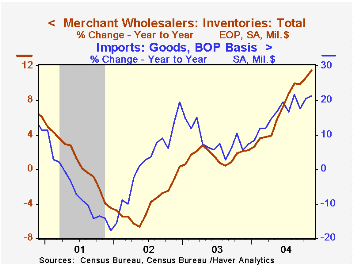
Overall business sales added 0.4% (+10.6% y/y) to the 11.4% pop in October.
The ratio of inventories-to-sales ticked up slightly to 1.31.
| Business Inventories | Nov | Oct | Y/Y | 2003 | 2002 | 2001 |
|---|---|---|---|---|---|---|
| Total | 1.0% | 0.4% | 7.9% | 1.9% | 1.5% | -4.5% |
| Retail | 1.1% | -0.4% | 6.2% | 4.9% | 6.0% | -2.8% |
| Retail excl. Autos | 0.9% | 0.5% | 5.4% | 3.0% | 2.6% | -1.1% |
| Wholesale | 1.1% | 1.1% | 11.5% | 2.2% | 0.4% | -4.5% |
| Manufacturing | 0.7% | 0.9% | 7.2% | -1.3% | -1.8% | -6.1% |
Tom Moeller
AuthorMore in Author Profile »Prior to joining Haver Analytics in 2000, Mr. Moeller worked as the Economist at Chancellor Capital Management from 1985 to 1999. There, he developed comprehensive economic forecasts and interpreted economic data for equity and fixed income portfolio managers. Also at Chancellor, Mr. Moeller worked as an equity analyst and was responsible for researching and rating companies in the economically sensitive automobile and housing industries for investment in Chancellor’s equity portfolio. Prior to joining Chancellor, Mr. Moeller was an Economist at Citibank from 1979 to 1984. He also analyzed pricing behavior in the metals industry for the Council on Wage and Price Stability in Washington, D.C. In 1999, Mr. Moeller received the award for most accurate forecast from the Forecasters' Club of New York. From 1990 to 1992 he was President of the New York Association for Business Economists. Mr. Moeller earned an M.B.A. in Finance from Fordham University, where he graduated in 1987. He holds a Bachelor of Arts in Economics from George Washington University.






